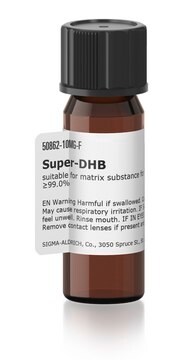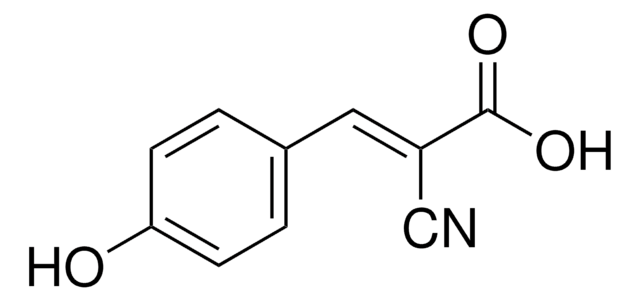727881
trans-2-[3-(4-tert-Butylphenyl)-2-methyl-2-propenylidene]malononitrile
≥98%
Synonym(s):
DCTB
Select a Size
Select a Size
About This Item
Recommended Products
assay
≥98%
≥98.0% (HPLC)
form
powder
functional group
nitrile
SMILES string
CC(=C/c1ccc(cc1)C(C)(C)C)\C=C(\C#N)C#N
InChI
1S/C17H18N2/c1-13(10-15(11-18)12-19)9-14-5-7-16(8-6-14)17(2,3)4/h5-10H,1-4H3/b13-9+
InChI key
OIASAVWSBWJWBR-UKTHLTGXSA-N
Looking for similar products? Visit Product Comparison Guide
Related Categories
Application
- Soluble Microporous Ladder Polymers Formed by Stepwise Nucleophilic Substitution of Octafluorocyclopentene: This study utilizes trans-2-[3-(4-tert-Butylphenyl)-2-methyl-2-propenylidene]malononitrile in the context of creating soluble microporous polymers, particularly highlighting its utility in enhancing the properties of these materials. The detailed characterization and application in ionization spectra are discussed (Krishnan and Parthiban).
signalword
Warning
hcodes
Hazard Classifications
Acute Tox. 4 Dermal - Acute Tox. 4 Inhalation - Acute Tox. 4 Oral
Storage Class
11 - Combustible Solids
wgk_germany
WGK 3
flash_point_f
Not applicable
flash_point_c
Not applicable
Choose from one of the most recent versions:
Certificates of Analysis (COA)
Don't see the Right Version?
If you require a particular version, you can look up a specific certificate by the Lot or Batch number.
Already Own This Product?
Find documentation for the products that you have recently purchased in the Document Library.
Customers Also Viewed
Our team of scientists has experience in all areas of research including Life Science, Material Science, Chemical Synthesis, Chromatography, Analytical and many others.
Contact Technical Service![trans-2-[3-(4-tert-Butylphenyl)-2-methyl-2-propenylidene]malononitrile matrix substance for MALDI-MS, ≥99.0% (HPLC)](/deepweb/assets/sigmaaldrich/product/structures/249/587/f8021369-f65a-413d-887d-3c8a4d2a248f/640/f8021369-f65a-413d-887d-3c8a4d2a248f.png)









